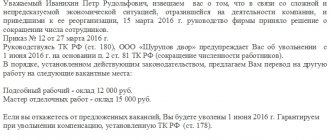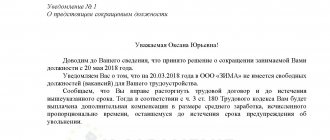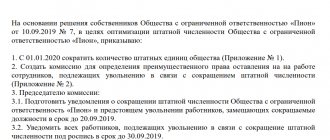Home / Dismissal and reduction / All about reducing the number or staff of employees - what is the difference between the procedures?
In times of financial instability, many employers are forced to resort to measures such as reducing the number of their subordinates. This procedure has a number of features, non-compliance with which can lead to problems with supervisory authorities and legal proceedings with subordinates.
This article will help you understand the difference between staff reduction and headcount. Let's consider all the pros and cons of this procedure. All presented materials will be supported by an analysis of judicial practice.
Why you need to know what the difference is between reducing the number or staff of employees
One of the most complex procedures preceding dismissal is layoff, since the Labor Code associates with its implementation many restrictions and guarantees that must be observed (Articles 179, 180 of the Labor Code of the Russian Federation, etc.).
Termination of an employment contract at the initiative of the employer in the event of a reduction in the number or staff of employees is provided for in clause 2, part 1, art. 81 Labor Code of the Russian Federation. The articles of the Labor Code of the Russian Federation use a general term that combines 2 grounds for termination of employment relations - “reduction in the number or staff of employees.” At the same time, there are no explanations for why the term is divided into 2 components in the code itself. They are not in the by-laws either. But such terminology existed in Soviet legislation.
Both the science of labor law and judicial practice know how headcount reduction differs from staff reduction, both in terms of substantive characteristics and the resulting legal consequences.
You need to know these differences:
- for the correct implementation of the procedure for determining the released and retained workers in accordance with the requirements of the Labor Code of the Russian Federation;
- making an entry in the work book in accordance with the content of the procedure performed.
Ultimately, the goal is to maximally respect the rights of workers in order to avoid sanctions and other consequences provided for by the Labor Code of the Russian Federation or Art. 5.27 of the Code of Administrative Offenses of the Russian Federation.
Unfortunately, as in many other cases, there were disagreements when delimiting the grounds for reduction. Let's consider existing points of view on this issue.
How do these concepts differ in practice?
On the issue of differences between staff reduction and headcount reduction, a stable position has been formed in judicial practice:
- A reduction in headcount is regarded as a partial reduction of work units in a certain position. For example, if the company has 7 positions for electricians, then after reduction, there may be 3 of them left.
- Staff reduction means the complete cancellation of a specific position, without taking into account how many people worked in it. That is, after the reduction, the position of electrician at the above-mentioned enterprise would be completely abolished.
General information about the procedure for dismissal due to staff reduction or headcount reduction is described in this article.
If we talk about benefits and compensation payments upon dismissal under clause 2 of Article 81 of the Labor Code of the Russian Federation, then in both cases they will be the same. But the guarantees provided to employees during layoffs are observed in different ways in practice. And in the event of labor disputes regarding violation of rights to these guarantees, the decisive role will be played by the wording in the dismissal order.
Controversy over the difference between downsizing and retrenchment
There are 2 points of view on this topic, from which different interpretations of the population decline follow:
- A downsizing is a reduction in the number of units per position.
This is the most common point of view. Since all positions are named in the staffing table, indicating the number of units for each, reduction is possible in 2 ways: by reducing the number of positions and by reducing staff.In this case, staff reduction is understood as follows:
- exclusion of job titles (i.e. all units for a given position);
replacement of some positions with others based on changes in functional responsibilities, volume of work, and qualification requirements.
- Downsizing is a reduction in the number of employees.
The staffing table implies a staff of a certain total number of units, which is approved by order of the manager. The unified form T-3 provides the corresponding line. However, it does not reflect the number of employees.Employees can work in the organization at a fractional rate or part-time. On the other hand, some positions may be vacant. Therefore, the total number of units in the state and the number of employees may not coincide.
In this regard, staff reduction is proposed to be understood as any measures related to a reduction in the number of units within one or more positions in the state, and a reduction in staff size means a reduction in the actual number of employees.
Another important aspect: when staffing is reduced, the total number of employees may not decrease, since the employer has the right to introduce new positions (professions, specialties) into the staffing table or create new structural units.
A fractional unit is equal to a whole unit. So, if an entire unit is reduced to 0.5, this is not considered a reduction in staff, but is a significant change in working conditions (Article 74 of the Labor Code of the Russian Federation, see the decision of the Pervomaisky District Court of Murmansk dated June 24, 2016 in case No. 2-6575 /2916).
Practical significance and application
Finding a practical application for the second position is more difficult. With any type of reduction, there is an obligation to offer existing vacant positions. At the same time, in judicial practice there has been a strong understanding that the determination, including commission, of retained and dismissed employees, taking into account Art. 179 of the Labor Code of the Russian Federation is carried out only when the number of staff is reduced, i.e. when the number of units for a certain position is reduced. This corresponds to the application of the first point of view. In this case, the interpretation is applied by the court based on the content of the changes, and not the name of the grounds for dismissal indicated by the employer.
In addition, as a result of the application of the second position, there is, in fact, an identification of the dismissal of an employee who did not agree with a significant change in working conditions under Art. 74 of the Labor Code of the Russian Federation, with a reduction in numbers. Such enforcement could not reflect the legal content of these changes.
Judicial practice on the differentiation of concepts
In judicial practice one can find examples of the application of a distinction based on the first of the above positions:
- Regardless of how the employer has outlined the measures it is taking to reduce the total number of employees, the court applies the rules regarding workforce reduction if the position being reduced remains on the organization’s staffing table. In this case, the circumstance of the existence of a position with the same name in other departments is taken into account. Thus, in one of the cases, a situation was considered when the head nurse of the rehabilitation department was dismissed due to staff reduction, while the organization as a whole had several units left in the position of head nurse. The court concluded that there was actually a reduction in the number of employees, and not a reduction in staff (see the decision of the Oktyabrsky District Court of Primorsky Krai dated January 10, 2017 in case No. 2-8/2017).
- Reverse example. In one of the cases, the employer indicated a reduction in headcount as the basis for dismissal, based on the fact that a division had been abolished. The court considered that there was a reduction in staff, since the plaintiff’s position was reduced. From this it was concluded that it is not necessary to carry out the procedure for determining the preemptive right provided for in Art. 179 of the Labor Code of the Russian Federation (see the decision of the Zavolzhsky District Court of Ulyanovsk dated February 27, 2017 in case No. 2-587/17).
As you can see, the first approach is more productive.
Before the procedure, the structure and number of employees is determined according to the organization’s documents.
A few words about the rules for staff reduction and dismissal
When carrying out staff reduction or dismissal, it is important to carry out the procedure itself as correctly as possible, prepare and formalize the necessary procedures, without which it will be difficult to do without in the future. If these documents were prepared incorrectly, then after the expiration of the established period it will be necessary to reinstate the person at his previous place of work and even pay him for the corresponding forced absence. The court may forcibly reinstate a person to his position if technical errors were made.
Important! This procedure includes several separate stages of work, each of which is carefully prepared.
Initially, the company's management department prepared an order for the subsequent reduction of people to the required number. It establishes the list of positions subject to reduction. For example, this order (a separate order is being prepared) directly establishes and approves a new staffing table, with additional adjustments and changes made that caused a reduction in the number of employed specialists and their number, which is also due to legal norms. Thus, the number of staff is reduced, which, at times, is a pressing condition for the entire production process. The main thing is to do this as correctly and competently as possible from the point of view of current legislation. If staff reductions are calculated correctly, no complications will arise.
Determining the number of employees and the number of vacancies
The main document defining the structure and number of personnel in an organization is the staffing table. You can learn about its preparation and see a sample in the article on the website at the link: “We are preparing a staffing table for an LLC (sample).”
It contains basic information about the structure of the organization, the number of positions and units for each position. Fractional values may also be indicated (for more details, see the article “Number of units in the staffing table - what is it?”). The importance of the staffing table for the correct implementation of reductions is emphasized by Rostrud in a letter dated January 21, 2014 No. PG/13229-6-1.
However, there is no information in it about which positions are vacant and which are filled. This information is reflected in the list of employees, including:
- names of positions in accordance with the staffing table;
- Full name of employees filling the position, or an indication of its vacancy;
- the size of the occupied or free staff unit (this unit can be equal to 0.35; 0.5; 1, etc.).
This document is widely used as a means of proving the existence of vacancies in cases of dismissal due to reduction (see the decision of the Kimovsky City Court of the Tula Region dated June 2, 2016 in case No. 2-390/2016).
Employees of a separate division are counted among the organization's employees and can be dismissed due to reduction, and not liquidation, even if it is carried out in relation to this division (see the appeal ruling of the Krasnoyarsk Regional Court dated October 11, 2017 in case No. 33-13564/2017 ).
Is it possible to challenge a reduction?
In case of significant violations in the layoff procedure, citizens will be able to go to court and seek reinstatement at work. This can be done within a month after reading the order or receiving the work book. If violations are confirmed, the following consequences occur:
- the dismissal order is subject to cancellation on the basis of a judicial act;
- a reduced position or staffing unit is subject to restoration;
- an employee whose rights were violated will be able to receive remuneration for the entire period of forced absence, as well as compensation for moral damage.
The employer is not prohibited from repeating the layoff procedure, in compliance with all legal requirements.
Another option is possible to challenge layoffs and reinstatement. Judicial practice considers as a violation of labor rights a situation when, within 6 months after the dismissal of a citizen, a new specialist is hired for his position. To do this, the previous position may be reintroduced into the staffing table, or the number of personnel may be increased.
The law recognizes such employer behavior as abuse of rights in relation to one or more employees. Under such circumstances, the original specialist can count on reinstatement at work, including through legal action.
Registration of staff or headcount reduction
Having determined how to change the number of employees and the structure of the organization, the employer issues an order on the basis of which the appropriate changes are made. This document may have different names.
Its most significant part is the approval of changes to the staffing table:
- When staffing is reduced, positions are eliminated.
- When staffing is reduced, the number of units per position decreases.
- When 2 procedures are carried out simultaneously for individual positions, the number of staff positions is reduced, and other positions are eliminated completely.
Vacant units subject to layoffs are removed first. In relation to a specific employee occupying a specific staff position, one of the procedures provided for by the Labor Code of the Russian Federation is carried out.
If he simultaneously occupies 2 redundant positions, i.e., in one of them he is a part-time worker (for more information about the concept, see the article at the link: “Combination and part-time work - what is the difference?”), then it is possible to simultaneously apply 2 reduction procedures, since the rights of part-time workers do not differ from the rights of other workers.
What's better?
Is there a difference for the employer and the laid-off employee in these concepts, what is better for them - downsizing or downsizing? At first glance it seems not. Reduction in both cases implies loss of work. And yet there is a difference.
The procedure for reducing staff is simpler for the employer. When reducing a position as a whole, the employer does not have to choose; he fires one or all employees working in the position being reduced.
When reducing one or more units, it is necessary to reasonably explain to the dismissed employees why the choice fell on them.
The employer has the right to retain the most promising, qualified specialists.
For employees, downsizing is more acceptable: they have the opportunity to prove their advantage over others and not lose their position.
Some employees who have been laid off may continue to work in the institution if they agree to change positions. The proposed replacement may be lower in status or less paid. The head of an enterprise should not transfer an employee from one position to another without his voluntary consent .
Assessing the legality of a reduction in numbers or staff
The question of the advisability of changes in the structure of the organization or staff of employees falls within the exclusive competence of the employer; the court has no right to discuss it (see, for example, the decision of the Oktyabrsky District Court of Samara dated October 17, 2017 in case No. 2-4389/2017). However, the legality of making certain changes to the staffing table and dismissal can be assessed by the Rostrudinspectorate or the court. In this case, the burden of proving the legality of actions rests with the employer (clause 23 of the resolution of the Plenum of the Armed Forces of the Russian Federation “On the practice of application...” dated March 17, 2004 No. 2).
Challenging is possible on various grounds, such as:
- reduction of occupied units if there are vacant ones;
- changing job titles while maintaining the same job function;
- failure to offer all available vacancies that correspond to the qualifications of the dismissed employee;
- incorrect determination of the preferential right to remain at work and other cases of violation of the established procedure.
IMPORTANT! The main procedural feature arising from the difference between the two types of reduction is the need to determine the preferential right to retain a job when reducing the number of employees for a certain position in accordance with Art. 179 Labor Code of the Russian Federation.
Let's take into account some nuances
When reducing the number or staff of employees (we have already figured out what the difference between these concepts is), it is necessary to follow a certain algorithm of actions:
- Create a reduction order.
- Notify employees.
- Offer available positions.
- Notify the employment service.
When implementing these points, you need to take into account some nuances, compliance with which will help you subsequently avoid problems with the courts. As for notifying employees, the deadlines are clearly stated here: the manager is obliged to warn subordinates at least 60 days before dismissal . Regarding the offer of vacant vacancies, due to different interpretations of the concepts of reduction of “staff” and “numbers”, with non-compliance with the rights of workers and subsequent litigation, judges make different decisions.
Let's look at the issue in more detail: when the number of employees decreases, some employees remain to work, while the management needs to choose who exactly this will be. Dismissed employees can sue because they were released from their positions illegally, did not exercise their right to the advantage of remaining in their positions (more qualified employees and certain categories of citizens have such a right: participants in hostilities, WWII, etc.), did not offer another vacancy. And in this case, the courts often side with the plaintiffs, reinstating them at work.
If the court finds that a person was fired illegally, the manager will have to pay a penalty, and in some cases, moral damages and lost profits.
When staffing is reduced, the situation looks somewhat different: since it is not the number of units that is canceled, but the entire position, the management does not have a question about which employees to fire and which to keep. In addition, people working in a certain specialty are often simply not suitable for another vacancy. And if the order specifically specifies a reduction in staff, in the event of labor disputes the court generally sides with the employer.
Benefits for employee and employer
If an employer decides to reduce the number of subordinates, he may try to persuade employees to write a statement of their own. This is not advisable; dismissal due to layoffs will be much more profitable for a specialist : in addition to severance pay, he will also receive compensation payments, the amount of which can reach up to 3 average monthly earnings.
As for the benefits of the employer, it would be more appropriate to write in the order “staff reduction” rather than “reduction in headcount.” When worded “staff reduction,” labor disputes regarding compliance with Article 179 of the Labor Code of the Russian Federation are most often resolved in favor of the employer; also, the manager does not have to think about who to keep in the position and who to fire.
Preferential right to remain at work in case of staff reduction
In the text of Part 1 of Art. 179 of the Labor Code of the Russian Federation there is no indication of its use only in one of the reduction procedures. This is due to the fact that it is used in 2 cases:
- When reducing the number of employees for a certain position.
- Selection of employees from among those being laid off for the proposed vacancies.
The essence of determining an advantage is to identify objective criteria by which employees are determined who best meet the qualification requirements (economic criterion). From among them, selection is further carried out according to socially significant characteristics (social criterion).
If, according to the first of the parameters, the employer has the right to independently determine the indicators that he considers significant for assessing work, taking into account the concept of qualifications given in Art. 195.1 of the Labor Code of the Russian Federation, then in the second case the criteria are established by direct transfer in Part 2 of Art. 179 of the Labor Code of the Russian Federation (presence of dependents, status of sole breadwinner, etc.). The list is open, but can only be supplemented by a collective agreement.
The criteria listed in Art. 179 of the Labor Code of the Russian Federation are applied consistently. As a rule, a special commission is formed for this purpose during the reduction procedure.
What is more beneficial for the parties?
It is clear that any reduction is clearly not a joy for workers.
However, if, when staffing is reduced, everyone who worked in a certain position will have to look for vacancies, the administration’s decision to reduce the number of employees gives responsible workers a chance to remain in the workplace.
On the other hand, since the law prohibits the dismissal of certain categories of workers, the situation for professionals may not be the best.
The employer, when reducing the number of subordinates, will also have a hard time, because it is necessary to make a difficult choice about dismissing a person with whom, perhaps, a friendly relationship has developed.
Experienced business consultants believe that the decision of the enterprise administration to reduce the number of employees brings tangible benefits to the company itself.
Thus, news of the upcoming compaction forces employees to observe discipline more carefully, show their effectiveness, and perform their job duties more responsibly.
Experts report cases of deliberate dissolution of such rumors among company employees to optimize work.










